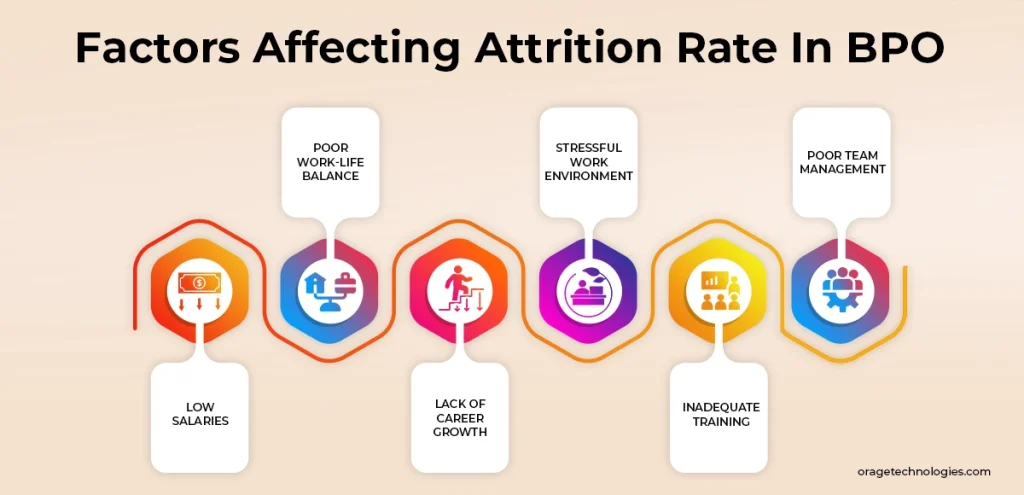
Arjun Seth has spent over 15 years working in the world of business, sales and operations. Having worked closely with teams at every level, he...
One of the most important things in any organization or company is to maintain productivity and efficiency. Many factors affect the normal workflow and, ultimately, the performance. One of the most hazardous ones is Attrition.
It is very challenging for business process outsourcing companies. From increasing the cost to affecting efficiency, it has many effects. So, let’s start to understand the Attrition meaning in BPO, Shrinkage, and the Attrition rate formula in BPO. Moreover, we will also explore some of the ways to reduce and control it.
What is Attrition Rate in BPO?

Attrition rate refers to the rate of people leaving an organization or company due to various factors. A low attrition rate suggests that something needs to be taken care of in the company. It is affected by various factors such as the work environment, perks, and benefits etc.
Companies with a low rate of attrition tend to suffer from poor performance, lower productivity, lower-quality service, etc. The BPO industry is very much affected by these factors as it is service-based.
Thus, it is important to keep track of the attrition rate in BPO.
How to Calculate Attrition Rate in BPO?
Measuring the attrition rate is the first step toward taking corrective measures. Here is the simple attrition rate formula in BPO:
| Attrition Rate (%) = (Number of Employees Who Left ÷ Average Number of Employees) × 100 |
Simple steps to use the attrition formula in BPO:
Step 1: Select the period for which you want to calculate the attrition rate.
Step 2: Count the total number of employees at the beginning and the end of a selected time period.
Step 3: Calculate the average by adding the total number of employees at the beginning and the end, and then dividing the result by 2
Step 4: Divide the number of employees who left the company in this period by the average you calculated earlier.
Step 5: Multiply the result by 100, and you’ll get the attrition rate of your company in that chosen time period.
If it seems complicated, let me explain it to you with an example. It’ll clear all the steps on how to use the attrition rate formula.
Example for calculating the Attrition Rate for one year:
- Number of employees at the start of the year: 200
- Number of employees at the end of the year: 180
- Average employees = (200 + 180) ÷ 2 = 190
- Employees who left = 200 – 180 = 20
Now, put these numbers in the Attrition formula

Attrition Rate = (20 ÷ 190) × 100 = 10.5%
10.5% is the annual attrition rate in this example. Similarly, you can calculate monthly as well as quarterly rates.
Common Mistakes When Calculating the Attrition Rate
Though calculating attrition is no difficult task. But even a minor mistake can lead to wrong figures. Here are some common mistakes that you must take care of:
- Not calculating the average number of employees correctly.
- Counting temporary, contract-based, and freelancers in the total number of employees
- Considering internal transfers as attrition
- Time period not selected for the measurement.
Factors Affecting Attrition Rate in BPO

According to the Economic Times, the average attrition rate in BPO has fallen to 17.4% from 19.4% in 2020. This is because of various factors. Some of the important factors in increasing the attrition rate are:
- Low salaries: When companies offer lower salaries than the industry standards, the employees tend to leave the company more often.
- Poor work-life balance: This has emerged as an important factor for the young generation. They are ready to quit their jobs for a better balance.
- Lack of career growth: Growth is a key factor that keeps any employee bound to the company. If they fall short of growth, then they start searching for another opportunity.
- Stressful work environment: With increasing awareness about mental health, people prefer a stress-free work environment.
- Inadequate training: Poor training can lead to more attrition. Employees may find better learning opportunities somewhere else.
- Poor team management: Team management plays an important role in keeping the interests of every team member in view. If team management is poor, people tend to leave more often.
Impact of High Attrition Rate in BPO
High attrition rates in India’s BPO sector are a significant concern. Report by Business Standards indicates that attrition rates in BPO companies are about 7.8 percentage points higher than in other industries. Moreover, the BPO sector is experiencing a rate of 23.5% in 2025 compared to the national average of 15.7%. In some cases, attrition rates have reached as high as 65%
Attrition leads to increased costs for hiring and training new staff. It also disrupts service quality and client satisfaction. Additionally, it disrupts workflow and reduces productivity, thus affecting the overall performance of an organization.
How to Control Attrition in BPO?
To reduce your Attrition, you need to take a few steps. It’s essential for every company that is focused on growth. Think, according to today’s generation, employees in 2025 are more focused on these things than just work.
- Better pay and incentives.
- Flexible shifts
- Workplace culture
- Regular feedback and appreciation
- Training and skill development Investment
- Visible growth paths for employees.
- Encourage internal promotions
When employees feel secure and happy, they stay longer.
Types of Attrition in BPO & Call Centers
There are three types of attrition in BPO and Call Centers: Voluntary, Involuntary, and Functional Attrition.
Voluntary Attrition: This happens when people leave a company for a better career or growth opportunity, or work environment.
Involuntary attrition: This kind of attrition happens when people leave an organisation due to underperformance, disciplinary action, or restructuring.
Functional attrition: Functional attrition occurs due to retirement, disability, or any other natural circumstance.
Difference Between Shrinkage Vs Attrition Rate

There are two key terms to understand productivity challenges in a company. The first one is the attrition rate in BPO, which represents the number of people leaving an organization in a specific period. The second term is shrinkage, which represents the unproductive time of employees due to scheduled or unscheduled tasks.
Both of these factors can potentially affect productivity. However, attrition can have a long-term impact.
| Shrinkage | Attrition | |
| Meaning | Non-productive time during working hours | People are leaving the organization. |
| Cause | Breaks, meetings, health issues, etc. | Career growth, bad work environment, etc |
| Control | Focus on workforce efficiency | Focus on a positive work environment, perks, and retention policies. |
Conclusion
Attrition is a major concern in BPO and call center businesses. It can impact stability, productivity, and quality of service. But with the right measurement and corrective measures, you can reduce it. Start by tracking it using the correct Attrition rate formula in BPO. Then, fix the root causes one by one. A happy employee is the best asset your company can have.
FAQs
The standard attrition rate in the BPO sector is around 30-45% yearly. However, it varies depending on various factors like work environment, perks, etc.
You can calculate shrinkage in BPO by following the given formula:
Shrinkage (%) = (Total shrinkage hours / Total available hours) X 100
No, 0% is not a good thing, as it might suggest a stagnancy phase in the company or potential overlooking of internal issues.

Arjun Seth has spent over 15 years working in the world of business, sales and operations. Having worked closely with teams at every level, he brings a real-world perspective to the challenges businesses face today. Over the years, he’s helped companies and startups across industries streamline processes, improve efficiency, and build stronger, more adaptable solutions. Through his writing, Arjun shares the lessons he’s learned along the way — the wins, the setbacks, and everything in between. His blogs aim to make business sales and operations easier to understand and apply, whether you're managing a team, leading a department, or setting the success of startups.
More Posts